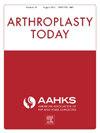调查全关节置换术后尿潴留:危险因素和术后结果。
IF 1.5
Q3 ORTHOPEDICS
引用次数: 0
摘要
背景:术后尿潴留(POUR)是已知的全关节成形术(TJA)后并发症,但其诊断标准、发病率和风险因素仍不一致。本研究旨在量化 POUR 的发生率,确定风险因素,并评估与 TJA 中导管插入相关的并发症:方法:对 2015 年 1 月至 2022 年 12 月间接受 TJA 手术的单中心队列进行回顾性研究。采用 3 种不同的诊断标准量化了 POUR 发生率。分析的变量包括年龄、性别、α-受体阻滞剂处方、手术关节、体重指数、美国麻醉医师协会评分、Charlson合并症指数分类和麻醉类型。比较了POUR和非POUR患者的并发症发生率。在POUR患者中,根据导管类型和频率对术后90天的肾脏和感染并发症进行了评估:在17220名TJA患者中,POUR发生率从20%(导尿)、25%(术后膀胱扫描> 500 mL)到29%(导尿和/或膀胱扫描)不等。高龄、男性、体重指数较低、夏尔森综合指数评分中等、全膝关节置换术、脊髓麻醉和使用α-受体阻滞剂的患者在 POUR 患者中的发病率明显更高。术后并发症(包括肾脏/感染并发症)的发生率在POUR和非POUR患者之间没有显著差异。在POUR患者中,使用4根以上导管的患者出现肾脏/感染并发症的几率明显增加(几率比=10.17,2.75,37.59):结论:TJA术后POUR的诊断差异依然存在。结论:TJA术后POUR的诊断变异性依然存在,在POUR管理方面,接受4次以上导管治疗的患者发生肾脏/感染并发症的风险是未接受导管治疗患者的10倍。减少导管插入频率并对易感患者进行风险分层可能有助于有效降低这些风险。本文章由计算机程序翻译,如有差异,请以英文原文为准。
Investigating Postoperative Urinary Retention: Risk Factors and Postsurgical Outcomes in Total Joint Arthroplasty
Background
Postoperative urinary retention (POUR), a known complication following total joint arthroplasty (TJA), remains inconsistent in its diagnostic criteria, prevalence, and risk factors. This study aims to quantify POUR rates, identify risk factors, and assess complications associated with catheterization in TJA.
Methods
A single-center cohort undergoing TJA between January 2015 and December 2022 was retrospectively reviewed. POUR rates were quantified using 3 different diagnostic criteria. Variables analyzed included age, sex, alpha-blocker prescription, operative joint, body mass index, American Society of Anesthesiologists score, Charlson Comorbidity Index classification, and anesthesia type. Complication rates between POUR and non-POUR patients were compared. Among POUR patients, 90-day postoperative renal and infectious complications were evaluated based on catheterization type and frequency.
Results
Among the 17,220 TJA patients identified, POUR incidence rates varied from 20% (catheterization), 25% (postoperative bladder scan > 500 mL), to 29% (catheterization and/or bladder scan). Advanced age, male gender, lower body mass index, moderate Charlson Comorbidity Index scores, total knee arthroplasty, spinal anesthesia, and alpha-blocker use were significantly more prevalent among POUR patients. The development of postoperative complications, including renal/infectious complications, was not significant between POUR and non-POUR patients. Among POUR patients, there was a significant increase in renal/infectious complications among patients who received 4+ catheters (odds ratio = 10.17, 2.75, 37.59).
Conclusions
Diagnostic variability in POUR after TJA persists. For POUR management, patients receiving 4+ catheters were at a 10-fold risk for renal/infectious complications compared to those without catheterization. Reducing catheterization frequency and employing risk stratification for susceptible patients may help mitigate these risks effectively.
求助全文
通过发布文献求助,成功后即可免费获取论文全文。
去求助
来源期刊

Arthroplasty Today
Medicine-Surgery
CiteScore
2.90
自引率
0.00%
发文量
258
审稿时长
40 weeks
期刊介绍:
Arthroplasty Today is a companion journal to the Journal of Arthroplasty. The journal Arthroplasty Today brings together the clinical and scientific foundations for joint replacement of the hip and knee in an open-access, online format. Arthroplasty Today solicits manuscripts of the highest quality from all areas of scientific endeavor that relate to joint replacement or the treatment of its complications, including those dealing with patient outcomes, economic and policy issues, prosthetic design, biomechanics, biomaterials, and biologic response to arthroplasty. The journal focuses on case reports. It is the purpose of Arthroplasty Today to present material to practicing orthopaedic surgeons that will keep them abreast of developments in the field, prove useful in the care of patients, and aid in understanding the scientific foundation of this subspecialty area of joint replacement. The international members of the Editorial Board provide a worldwide perspective for the journal''s area of interest. Their participation ensures that each issue of Arthroplasty Today provides the reader with timely, peer-reviewed articles of the highest quality.
 求助内容:
求助内容: 应助结果提醒方式:
应助结果提醒方式:


